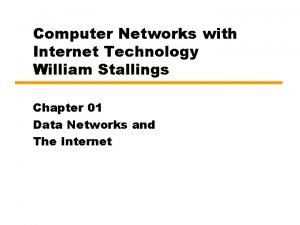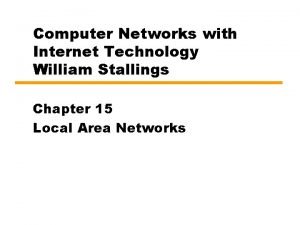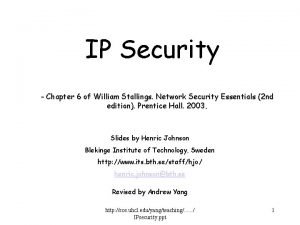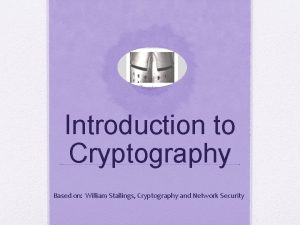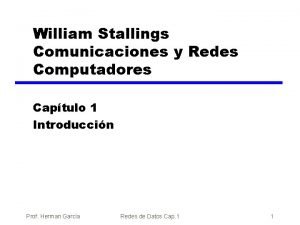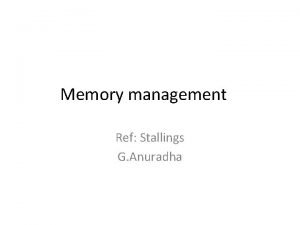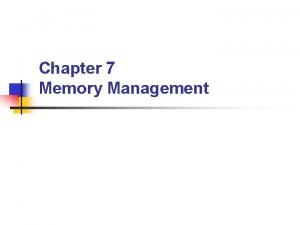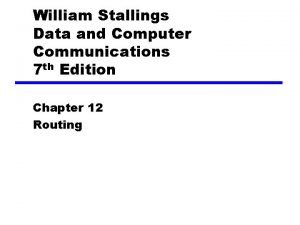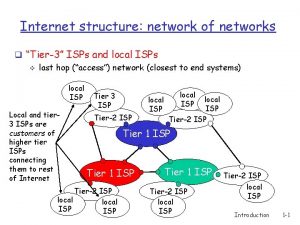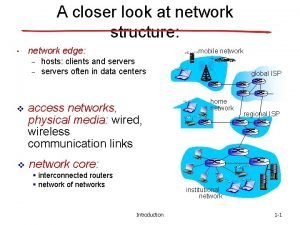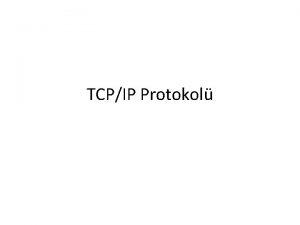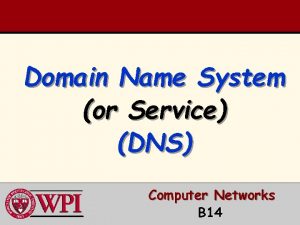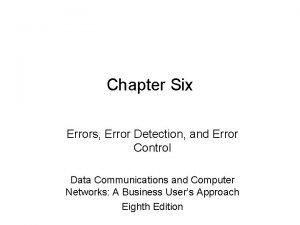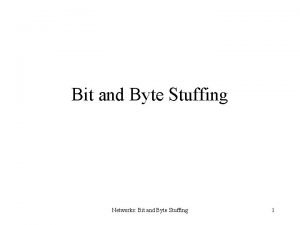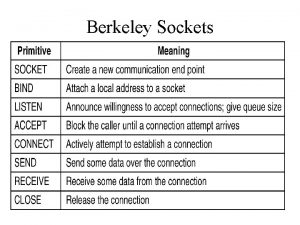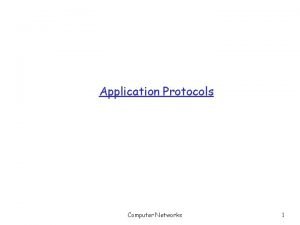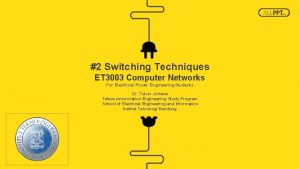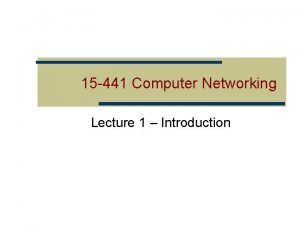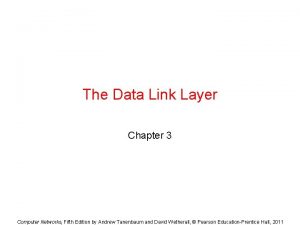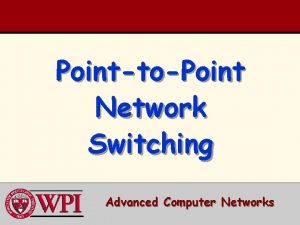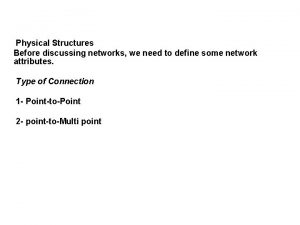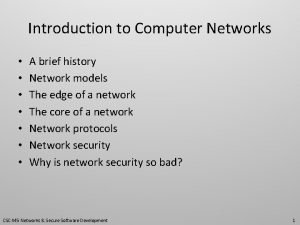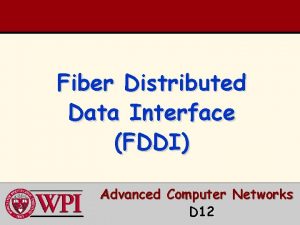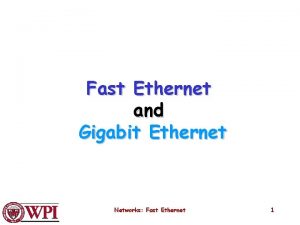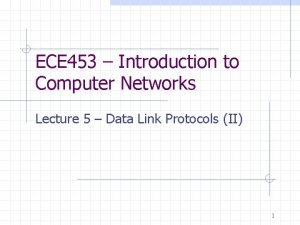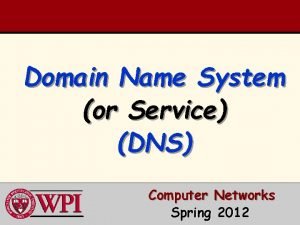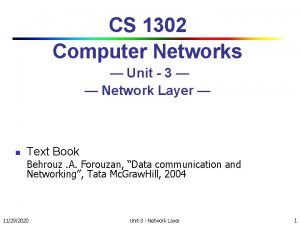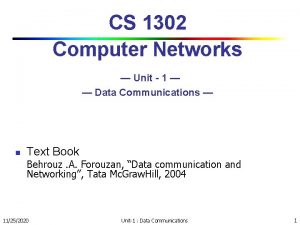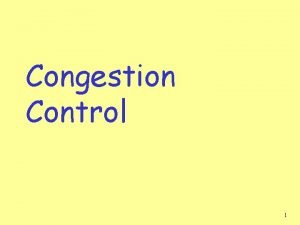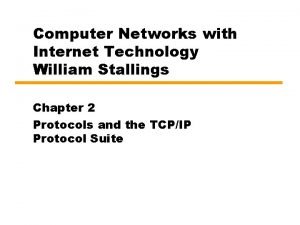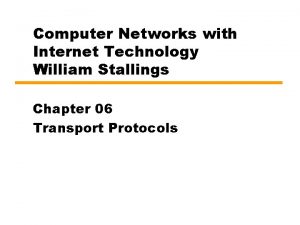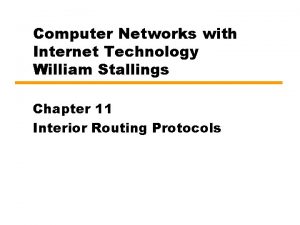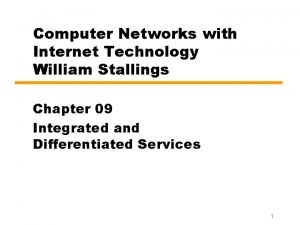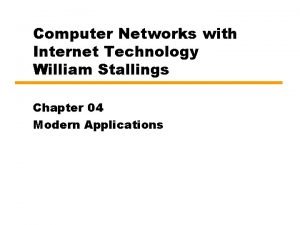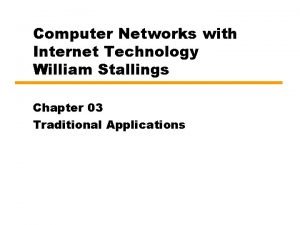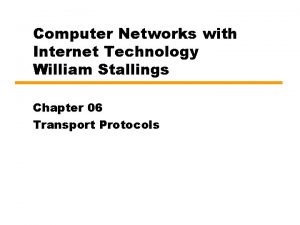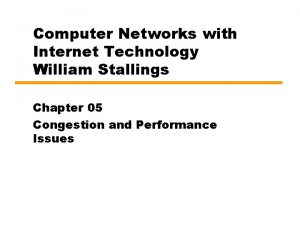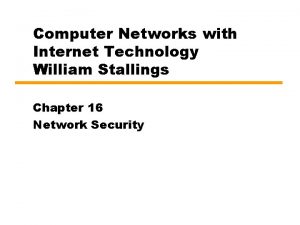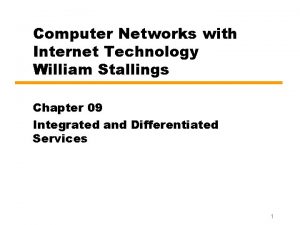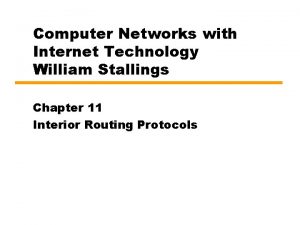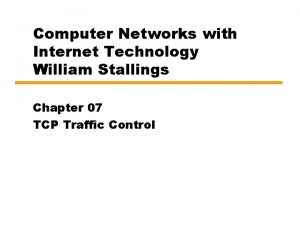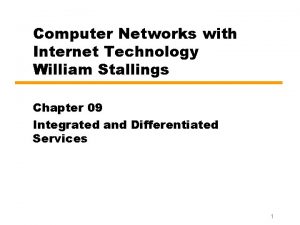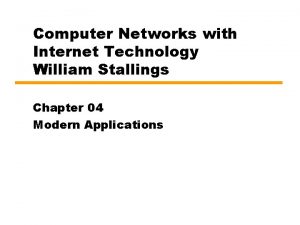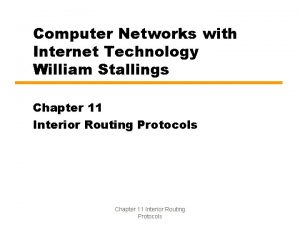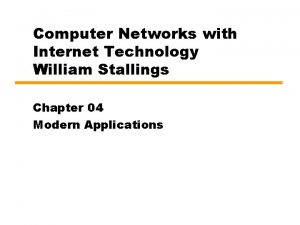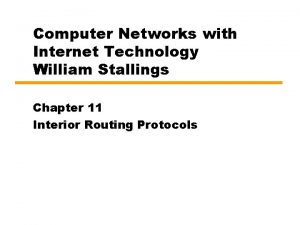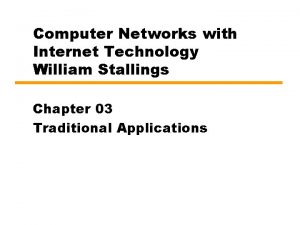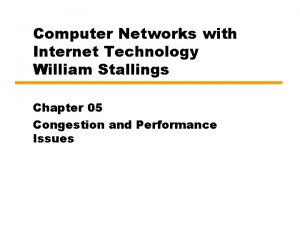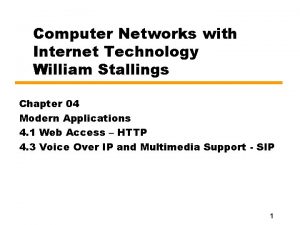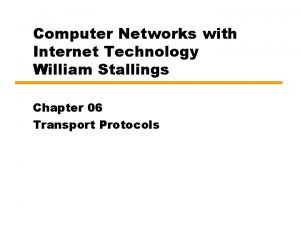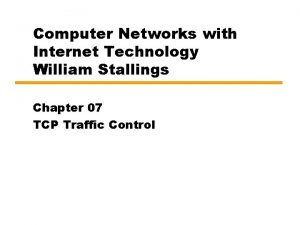Computer Networks with Internet Technology William Stallings Chapter











































































- Slides: 75

Computer Networks with Internet Technology William Stallings Chapter 06 Transport Protocols 1

Transport Protocols • The transport protocol provides an end-to-end data transfer service that shields upper-layer protocols from the details of the intervening network. • Two types of transport service — connection oriented, e. g. TCP — connectionless (datagram), e. g. UDP 2

Connection Oriented Transport Protocol Mechanisms • Logical connection — Establishment — Maintenance — Termination • Reliable • e. g. TCP 3

(1). Reliable Sequencing Network Service • Assume the network service accepts messages of arbitrary length. • Assume virtually 100% reliable delivery by network service —e. g. reliable packet switched network using X. 25 —e. g. frame relay using LAPF control protocol —e. g. IEEE 802. 3 using connection oriented LLC service • In the above cases, the transport protocol is used as an end-to-end protocol between two systems on same network 4

Issues in a Simple Transport Protocol • • Addressing Multiplexing Flow Control Connection establishment and termination 5

Addressing • Target user specified by: —User identification • Usually host, port – Called a socket in TCP • Port represents a particular transport service (TS) user —Transport entity identification • Generally one per host • If more than one, then usually one of each type – Specify transport protocol (TCP, UDP) —Host address • An attached network device • In an internet, a global internet address —Network number 6

Finding Addresses • Four methods —Know address ahead of time • e. g. collection of network device stats —Well known addresses (Table 6. 1, p. 205) —Name server —Sending process request to well known address 7

Multiplexing • Multiplexing/Demultiplexing • Multiple users employ same transport protocol • User identified by port number or service access point (SAP) 8

Flow Control (5. 7, p. 188) • Flow control is a protocol mechanism that enables a destination entity to regulate the flow of packets sent by a source entity. • Limits amount or rate of data sent • Reasons: —Source may send PDUs faster than destination can process headers —Higher-level protocol user at destination may be slow in retrieving data —Destination may need to limit incoming flow to match outgoing flow for retransmission 9

Flow Control • Flow control at the transport layer is rather complicated. —Longer transmission delay between transport entities • Delay in communication of flow control info —Variable transmission delay • Difficult to use timeouts • Flow may be controlled because: —The receiving user can not keep up —The receiving transport entity can not keep up • Results in buffer filling up 10

Coping with Flow Control Requirements • Do nothing —Segments that overflow are discarded —Sending transport entity will fail to get ACK and will retransmit (Shame!) • Thus further adding to incoming data • Backpressure —Refuse further segments —If multiple connections are multiplexed, flow control is excised only on the aggregate of all connections. • Use credit scheme 11

Credit Scheme (Used in TCP) • To overcome the inefficiencies of the stop-andwait scheme, in which only one PDU at a time can be in transit. • Decouples flow control from ACK —May ACK without granting credit and vice versa • Each octet has sequence number • Each transport segment has the following fields in header —sequence number (seq. ) —acknowledgement number (ack. ) —window size 12

Allowing multiple PDUs in transit • How to do it? —Receiver allocates a buffer space to hold PDUs —Sender is allowed to send a number of PDUs without waiting for an ack —To keep track of which PDUs have been acknowledged, sequence numbers are used. 13

Use of Header Fields • When sending, seq number is that of first octet in segment • ACK includes AN=i, W=j • AN=i All octets through SN=i -1 acknowledged —Next expected octet is i • W=j Permission to send additional window of j octets —i. e. Octets through i+j-1 SN: Sequence number AN: Acknowledgement number W: Window Size 14

Figure 6. 1 Example of TCP Credit Allocation Mechanism 15

Figure 6. 2 Sending and Receiving Flow Control Perspectives 16

17520 (3718091612 ~ 3718091612+17519) My PC 10. 13. 137 AN = 3718091612 W = 17520 FTP Server 163. 22. 12. 51 17

3718091612 + 1460 = 3718093072 16060 (3718093072 ~ 3718091612+17519) My PC 10. 13. 137 SN = 3718091612 Data: 1460 octets FTP Server 163. 22. 12. 51 18

= 3718091612 + 1460 3718093072 + 1460 = 3718094532 13600 (3718094532 ~ 3718091612+17519) My PC 10. 13. 137 SN = 3718093072 Data: 1460 octets FTP Server 163. 22. 12. 51 19

= 3718093072 + 1460 17520 (3718094532 ~ 3718094532+17519) My PC 10. 13. 137 AN = 3718094532 W = 17520 FTP Server 163. 22. 12. 51 20

21

Establishment and Termination • Connection establishment —Allow each end to know the other exists —Negotiation of optional parameters —Triggers allocation of transport entity resources • By mutual agreement 22

Figure 6. 3 Simple Connection State Diagram 23

Figure 6. 4 Connection Establishment Scenarios 24

Not Listening • A SYN comes in while the requested TS user is idle (not listening). — Reject with RST (Reset) — Queue request until matching open issued — Signal TS user to notify of pending request 25

Termination • • Either or both sides By mutual agreement Abrupt termination Or graceful termination —Close wait state must accept incoming data until FIN received 26

Side Initiating Termination • TS user Close request • Transport entity sends FIN, requesting termination • Connection placed in FIN WAIT state —Continue to accept data and deliver data to user —Not send any more data • When FIN received, inform user and close connection 27

Side Not Initiating Termination • FIN received • Inform TS user and place connection in CLOSE WAIT state — Continue to accept data from TS user and transmit it • TS user issues CLOSE primitive • Transport entity sends FIN • Connection closed • All outstanding data is transmitted from both sides • Both sides agree to terminate 28

(2). Unreliable Network Service • E. g. —internet using IP, —frame relay using LAPF —IEEE 802. 3 using unacknowledged connectionless LLC • Segments may get lost • Segments may arrive out of order 29

Problems • • Ordered Delivery Retransmission strategy Duplication detection Flow control Connection establishment Connection termination Failure recovery 30

Ordered Delivery • • Segments may arrive out of order Number segments sequentially TCP numbers each octet sequentially Segments are numbered by the first octet number in the segment 31

Retransmission Strategy • • Segment damaged in transit Segment fails to arrive Transmitter does not know of failure Receiver must acknowledge successful receipt —Doesn’t require one ACK per segment —Use cumulative acknowledgement • Time out waiting for ACK triggers re-transmission — Retransmission timer 32

Transport Protocol Timers 33

Duplication Detection • If ACK lost, segment is re-transmitted • Receiver must recognize duplicates • Duplicate received prior to closing connection —Receiver assumes ACK lost. ACKs the duplicate —Sender must not get confused with multiple ACKs —Sequence number space large enough to not cycle within maximum life of segment • Duplicate received after closing connection — See “Connection Establishment” 34

Figure 6. 5 Example of Incorrect Duplicate Detection Sequence space: 1600 Segment: SN = 1 is considered as a duplicate. Sequence number space should be long enough. 35

Flow Control • • Credit allocation Problem if AN=i, W=0 closing window Send AN=i, W=j to reopen, but this is lost Sender thinks window is closed, receiver thinks it is open • Use window timer • If timer expires, send something —Could be re-transmission of previous segment 36

Connection Establishment • Two way handshake — A send SYN, B replies with SYN — Lost SYN handled by re-transmission • Can lead to duplicate SYNs — Ignore duplicate SYNs once connected • Lost or delayed data segments can cause connection problems (see Fig. 6. 6) — Segment from old connections — Start segment numbers far removed from previous connection • Use SYN i • Need ACK to include i • Solved using Three Way Handshake 37

Figure 6. 6 Two-Way Handshake Problem with Obsolete Data Segment Start each new connection with a different SN far from the most recent connection. 38

Figure 6. 7 Two-Way Handshake Problem with Obsolete SYN Segments A does not know that SYN k was discarded. SYN should be acknowledged. 39

Figure 6. 8 TCP Entity State Diagram SV: state vector MSL: maximum segment lifetime 40

Figure 6. 9 Examples of Three-Way Handshake 41

Connection Termination • Entity in CLOSE WAIT state sends last data segment, followed by FIN • FIN arrives before last data segment • Receiver accepts FIN — Closes connection — Loses last data segment See Figure 6. 3 • Associate sequence number with FIN • Receiver waits for all segments before FIN sequence number • Loss of segments and obsolete segments — Must explicitly ACK FIN 42

Graceful Close • Send FIN i and receive AN i • Receive FIN j and send AN j • Wait twice maximum expected segment lifetime 43

Failure Recovery • After transport entity restarts, state info of all active connections is lost. • Connection is half open — Side that did not crash still thinks it is connected • Close connection using persistence timer — Wait for ACK for (time out) * (number of retries) — When expired, close connection and inform user • When a transport entity fails and quickly restarts — Send RST i in response to any i segment arriving • TS User must decide whether to reconnect — Problems with lost or duplicate data 44

6. 2 TCP Services • Transmission Control Protocol —Connection oriented —RFC 793 • TCP service provides the reliable end-to-end transport of data between host processes. • Categories of TCP services: —Multiplexing (via ports) —Connection management —Data transport —Special capabilities (push, urgent) —Error reporting 45

TCP Multiplexing & Connection Management • Multiplexing — TCP can simultaneously provide service to multiple processes — Process identified with port • Connection Management — Establishment, Maintenance, and Termination — Set up logical connection between sockets — Connection between two sockets may be set up if: • No connection between the sockets currently exists • Internal TCP resources (e. g. , buffer space) sufficient • Both users agree — Maintenance supports data transport and special capability services — Termination either abrupt or graceful • Abrupt termination may lose data • Graceful termination prevents either side from shutting down until all outstanding data have been delivered 46

Figure 6. 10 Multiplexing Example 47

Data Transport • Full duplex • Timely — Associate timeout with data submitted for transmission — If data not delivered within timeout, user notified of service failure and connection abruptly terminates • Ordered • Labelled — Establish connection only if security designations match (IP Options) — If precedence levels do not match, higher level used • Flow controlled • Error controlled — Simple checksum — Delivers data free of errors within probabilities supported by checksum 48

Special Capabilities • Data stream push — TCP decides when enough data available to form segment — Push flag requires transmission of all outstanding data up to and including that labelled — Receiver will deliver data in same way • Urgent data signalling — Tells destination user that significant or "urgent" data is in stream Destination user determines appropriate action Error Reporting — TCP will report service failure due to internetwork conditions for which TCP cannot compensate 49

TCP Service Primitives • Services defined in terms of primitives and parameters • Primitive specifies function to be performed — Table 6. 4, Table 6. 5 • Parameters pass data and control information — Table 6. 6 50

Table 6. 4 TCP Service Request Primitives 51

Table 6. 5 TCP Service Response Primitives 52

Figure 6. 11 Use of TCP and IP Service Primitives 53

6. 3 TCP Basic Operation • Data transmitted in segments — TCP header and portion of user data — Some segments carry no data • For connection management • • Data passed to TCP by user in sequence of Send primitives Buffered in send buffer TCP assembles data from buffer into segment and transmits Segment transmitted by IP service Delivered to destination TCP entity Strips off header and places data in receive buffer TCP notifies its user by Deliver primitive that data are available 54

Figure 6. 12 Basic TCP Operation 55

Difficulties • Segments may arrive out of order —Sequence number in TCP header • Segments may be lost —Sequence numbers and acknowledgments —TCP retransmits lost segments • Save copy in segment buffer until acknowledged 56

Figure 6. 13 TCP Header Page 228~229 57

TCP Options • Maximum segment size — Included in SYN segment • Window scale — Included in SYN segment — Window field gives credit allocation in octets — With Window Scale value in Window field multiplied by 2 F • F is the value of window scale option • Sack-permitted — Selective acknowledgement allowed • Sack — Receiver can inform sender of all segments received successfully — Sender retransmit segments not received • Timestamps — Send timestamp in data segment and return echo of that timestamp in ACK segment 58

59

Items Passed to IP • TCP passes some parameters down to IP —Precedence —Normal delay/low delay —Normal throughput/high throughput —Normal reliability/high reliability —Security 60

TCP Mechanisms (1) • Connection establishment —Three way handshake —Between pairs of ports —One port can connect to multiple destinations 61

TCP Mechanisms (2) • Data transfer —Logical stream of octets —Octets numbered modulo 232 —Flow control by credit allocation of number of octets —Data buffered at transmitter and receiver 62

TCP Mechanisms (3) • Connection termination —Graceful close —TCP users issues CLOSE primitive —Transport entity sets FIN flag on last segment sent —Abrupt termination by ABORT primitive • Entity abandons all attempts to send or receive data • RST segment transmitted 63

Implementation Policy Options • • • Send policy Deliver policy Accept policy Retransmit policy Acknowledge policy 64

Send Policy • If no push or close TCP entity transmits at its own convenience • Data buffered at transmit buffer • May construct segment per data batch • May wait for certain amount of data 65

Deliver Policy • In absence of push, deliver data at own convenience • May deliver as each in order segment received • May buffer data from more than one segment 66

Accept Policy • Segments may arrive out of order • In order —Only accept segments in order —Discard out of order segments • In windows —Accept all segments within receive window 67

Retransmit Policy • TCP maintains queue of segments transmitted but not acknowledged • TCP will retransmit if not ACKed in given time —First only: one retransmission timer for the queue / first —Batch: one retransmission timer for the queue / all —Individual: one retransmission timer per segment Acknowledge Policy • Immediate: Immediately send ACK • Cumulative: piggyback the ACK 68

6. 4 UDP • User Datagram Protocol (UDP) —Connectionless —RFC 768 • Connectionless service for application level procedures —Unreliable —Delivery and duplication control not guaranteed • Reduced overhead • e. g. network management 69

UDP Uses • • Inward data collection Outward data dissemination Request-Response Real time application 70

Figure 6. 14 UDP Header 71

Assignment • Use Wireshark to capture TCP traffic — Open: 3 -way Handshaking — Close: 4 -way Handshaking — Trace of SN, AN — TCP Options in SYN • Use Wireshark to capture UDP Traffic 72

73

74

75
 William stallings computer networks
William stallings computer networks William stallings computer networks
William stallings computer networks Computer organization and architecture william stallings
Computer organization and architecture william stallings William stallings data and computer communications
William stallings data and computer communications Network security essentials 5th edition
Network security essentials 5th edition Network security essentials william stallings ppt
Network security essentials william stallings ppt William stallings
William stallings Congruence relation
Congruence relation Stallings william comunicaciones y redes de computadores
Stallings william comunicaciones y redes de computadores Cryptography william stallings
Cryptography william stallings Datagram networks and virtual circuit networks
Datagram networks and virtual circuit networks Basestore iptv
Basestore iptv Internet transport protocol in computer networks
Internet transport protocol in computer networks Computer networks and internets with internet applications
Computer networks and internets with internet applications Definition of computer
Definition of computer Fixed partitions
Fixed partitions Garbage pickup stallings
Garbage pickup stallings Ovid metamorphoses daphne and apollo
Ovid metamorphoses daphne and apollo Metodo stallings
Metodo stallings Least cost routing algorithm
Least cost routing algorithm Chapter 1 information technology the internet and you
Chapter 1 information technology the internet and you Chapter 1 information technology the internet and you
Chapter 1 information technology the internet and you Tier 3 isp
Tier 3 isp Internet structure network of networks
Internet structure network of networks The internet is a combination of networks glued together by
The internet is a combination of networks glued together by Osi vs tcp/ip
Osi vs tcp/ip Chapter 12 computer technology in health care
Chapter 12 computer technology in health care Internet or internet
Internet or internet Crc in computer networks
Crc in computer networks Crc in computer networks
Crc in computer networks Traffic management in computer networks
Traffic management in computer networks Tpdu in computer networks
Tpdu in computer networks What is optimality principle in computer networks
What is optimality principle in computer networks Snmp supports which formatted protocol
Snmp supports which formatted protocol What is optimality principle in computer networks
What is optimality principle in computer networks Business application in computer network
Business application in computer network Dns in computer networks
Dns in computer networks Integrated and differentiated services in computer networks
Integrated and differentiated services in computer networks Icmp in computer networks
Icmp in computer networks Web and http in computer networks
Web and http in computer networks Character stuffing in computer networks
Character stuffing in computer networks Dns in computer networks
Dns in computer networks Computer networks assignment
Computer networks assignment Distributed systems vs computer networks
Distributed systems vs computer networks Routing algorithms in computer networks
Routing algorithms in computer networks Crc example
Crc example Error detection and correction in computer networks
Error detection and correction in computer networks Error control in computer networks
Error control in computer networks What is optimality principle in computer networks
What is optimality principle in computer networks Data link layer switching in computer networks
Data link layer switching in computer networks Layered tasks in computer network
Layered tasks in computer network Bit stuffing in hdlc
Bit stuffing in hdlc Byte stuffing example
Byte stuffing example Character stuffing and bit stuffing in computer networks
Character stuffing and bit stuffing in computer networks Berkeley socket
Berkeley socket What is the reverse request protocol?
What is the reverse request protocol? In ftp protocol client contacts server using
In ftp protocol client contacts server using Principles of network applications
Principles of network applications Https://speakerdeck.com/
Https://speakerdeck.com/ Cmu 15-441
Cmu 15-441 Utopian simplex protocol in computer networks
Utopian simplex protocol in computer networks Sonet network
Sonet network Cell switching in computer networks
Cell switching in computer networks Physical structures in computer networks
Physical structures in computer networks Osi model mnemonic
Osi model mnemonic The network layer is concerned with of data
The network layer is concerned with of data Brief history of computer network
Brief history of computer network What is fddi in computer network
What is fddi in computer network Fast ethernet in computer networks
Fast ethernet in computer networks Exponential backoff in computer networks
Exponential backoff in computer networks Unrestricted simplex protocol in computer networks
Unrestricted simplex protocol in computer networks Dns in computer networks
Dns in computer networks Analog and digital signals in computer networking
Analog and digital signals in computer networking Cs1302 computer networks
Cs1302 computer networks Cs1302 computer networks
Cs1302 computer networks Congestion control principles
Congestion control principles
